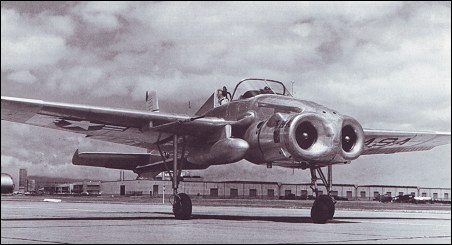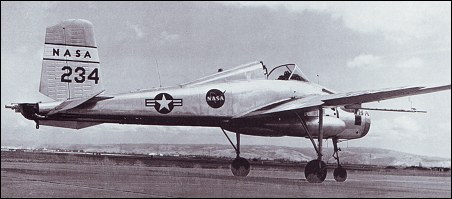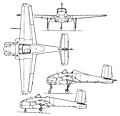 |
Bell Model 68 X-141957 |  |
| VTOL AIRCRAFT | Virtual Aircraft Museum / USA / Bell |
 |
Although the ATV had never completed a full transition, it was considered a successful experiment for it proved the feasibility of a jel-powered VTOL aircraft and attracted the interest of the Air Force. Bell then decided to follow on by designing a completely new test-bed aircraft with enlarged capabilities. In July 1955, a new programme was initiated with the awarding of an Air Force contract to Bell for VTOL research which eventually led to the designing of the Bell Model 68 or X-14. The design team, led by M McEuen, worked fast so that assembly of the unique prototype could be undertaken within three months. The X-14 was an open-cockpit mid-wing monoplane of all-aluminium construction. It was powered by two 707kg Armstrong Siddeley Viper 8 axial-flow turbojets mounted horizontally side-by-side in the forward fuselage. Thrust diverters were mounted behind the engines (in place of the original tailpipes) to deflect the jet thrust towards the ground during take-off and landing. The X-14 was thus able to raise itself vertically off the ground by direct jet lift, with its fuselage still in the horizontal position. At a safe height, the jet thrust was to be deflected slightly rearward to produce a forward thrust in addition to jet lift. When the forward speed was considered sufficient for the fixed wings to provide lift all the thrust was directed aft and the aircraft could fly in a conventional manner. During take-off, landing, hovering and flight at low speeds, directional control was effected by means of compressed-air nozzles located at the wingtips and tail. Much of the aircraft was assembled from various existing aircraft components. A Beechcraft Model 35 Bonanza provided the wings, parts for the undercarriage and ailerons, and a Beechcraft T-34A Mentor provided the tail section. Ground testing was begun in October 1956 by which time the engines and exhaust nozzle system were under test at All-American Engineering. During the ground testing, it was discovered that the arrangement of the exhaust system created a low-pressure area just beneath the aircraft preventing takeoff. This problem was overcome by lengthening the undercarriage by 0.6m. On 17 February, 1957, just over 18 months after go-ahead, the X-14, flown by Bell test pilot Dave Howe, completed its first successful hovering flight at Bell's Niagara Falls facility. This maiden flight was followed in June by the first partial transition and by the first complete VTOL cycle on 24 May, 1958. The aircraft was then taken on charge by the Air Force, which turned it over to NASA. The X-14 was received by NASA at Ames Research Center (Moffett Field, California) on 2 October, 1959, but the preliminary flight-test programme indicated that it was seriously underpowered. A modification programme was initiated to increase power: the two Armstrong Siddeley Viper 8 turbojets were replaced by two 1215kg General Electric J85-GE-5s, which virtually doubled the available thrust. Designated X-14A and registered N234NA, the aircraft was back in the flight-test programme in 1961 and began exploring several specific areas such as V/STOL handling qualities and control concepts. The X-14A participated in various research programmes for the next eleven years when its J85-GE-5s were replaced by 1368kg J85-GE-19s and a programmable computer permitting duplication of the flight characteristics of various VTOL aircraft was installed (the X-14A then becoming known as the X-14B). The aircraft flew with its new engines in February 1971 and was used for ten more years. More than 25 test pilots came from around the world to fly the X-14B to gain experience before proceeding to other V/STOL prototypes. Neil Armstrong once flew it as a Lunar lander. These test flights continued until 29 May, 1981, when the X-14B was victim of a hard landing accident which occurred following loss of roll control while making a ramp hover. The problem was traced to saturation of the VSCAS (Variable Stability Control Augmentation System) autopilot roll servos. The landing caused the collapse of the main undercarriage and ruptured a fuel tank. The tail was seriously damaged in the ensuing fire. Fortunately, the pilot, Ron Gerdes, escaped uninjured. Following this accident, the X-14B was never flown again and the necessary repairs were never made. It was put into temporary storage at NASA Ames Research Center and, in February 1989, was shipped to the US Army Air Museum at Fort Rucker in Alabama. Alain J Pelletier "Bell Aircraft since 1935", 1992
Joe Starns, e-mail, 08.12.2020  Ginger Harris Ginger HarrisThe Museum, and the X-14, have moved to Eagle Creek Airpark, outside Indianapolis, Indiana. Phillip Gindelberger, e-mail, 01.04.2022  Joe Starns Joe StarnsDo you know if this information is still accurate? If so I might just have to go visit Eagle Creek and see it for myself. Joe Starns, e-mail, 01.04.2022  Phillip Gindelberger Phillip GindelbergerInformation is still accurate. Just spoke with Rick Ropkey. It is still under restoration at Eagle Creek, pending construction of some new hangars. It is not open to the pubic, but visits could be arranged. His son Noble is at 317-654-4588 and the person I have had the most contact with. Joe Starns, e-mail, 09.12.2020  hualunjia hualunjiaI think you mean: XV-15. A truly outstanding tech demonstrator.
|  COMPANY PROFILE | |||||||||||||||||||||||||||||||||||||||||||||||||||||
 |

|



Found it.
reply